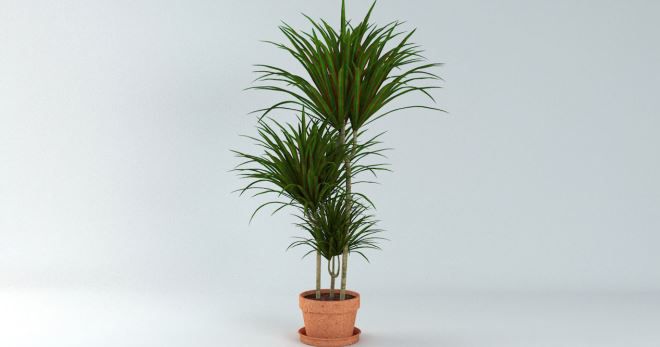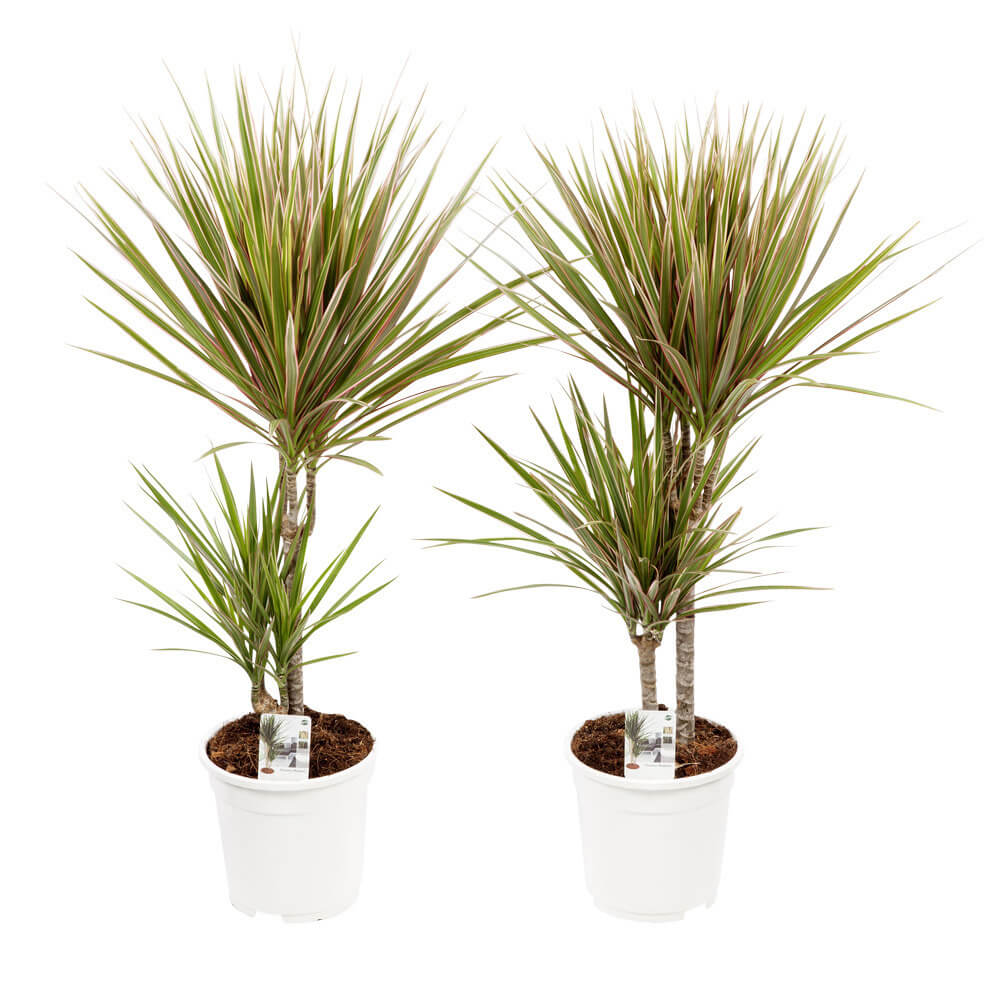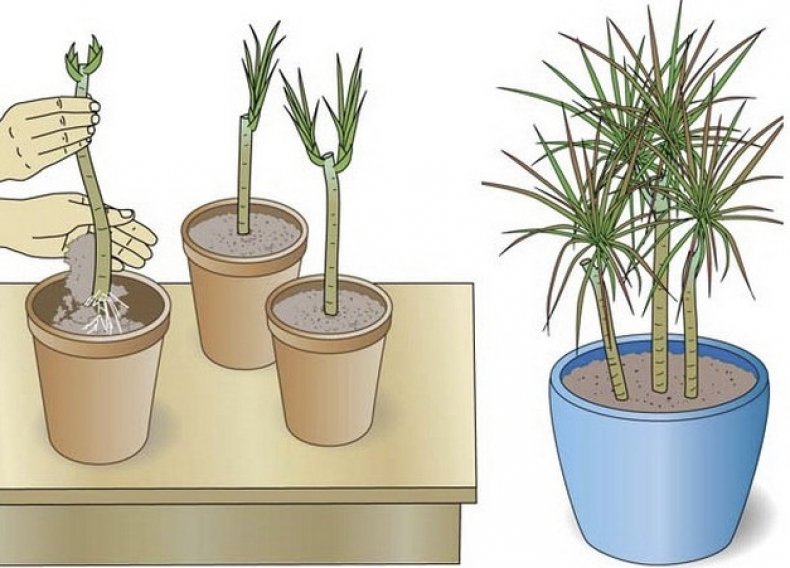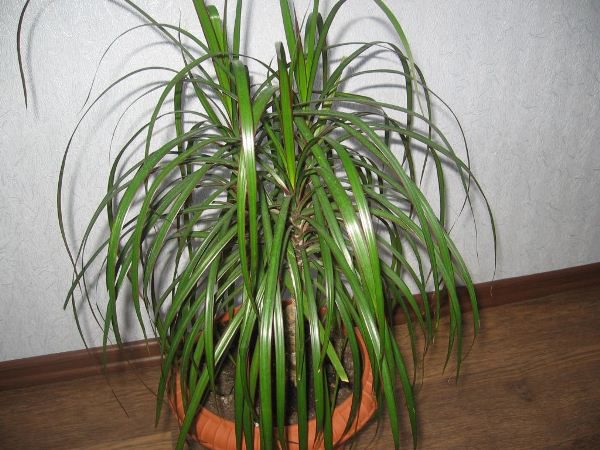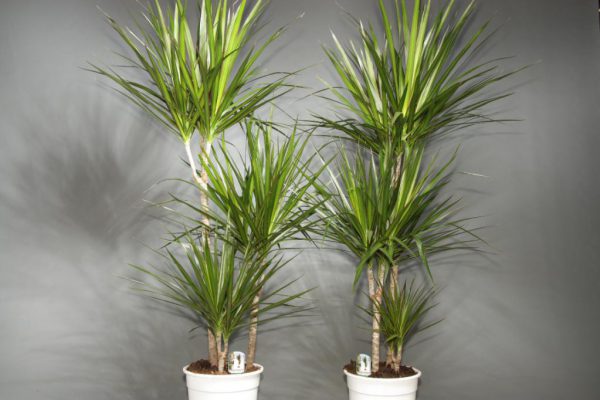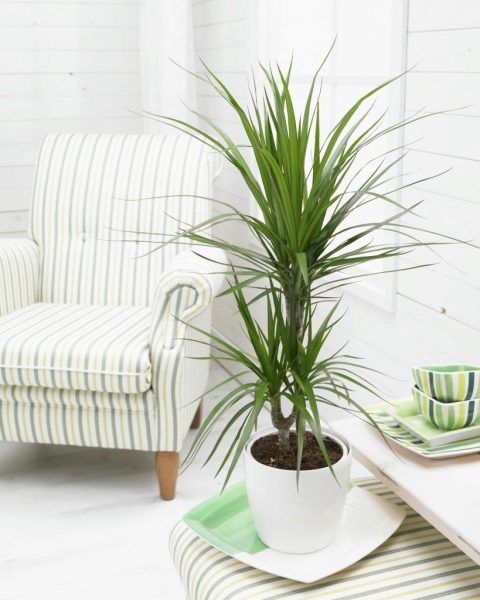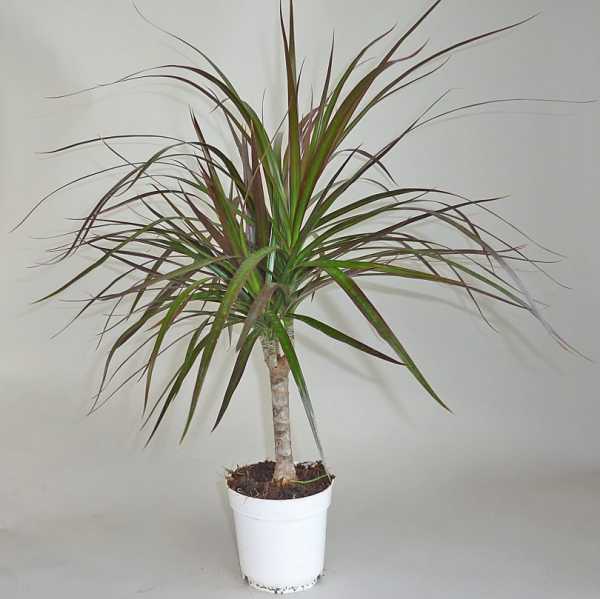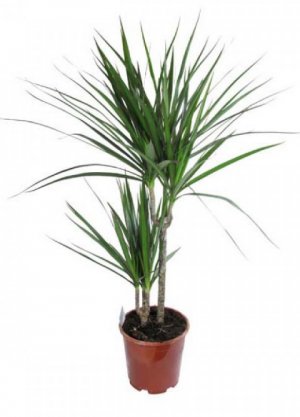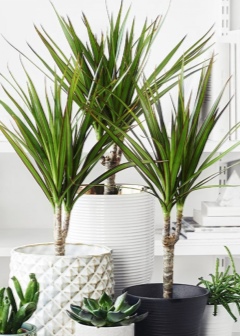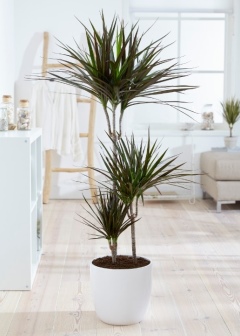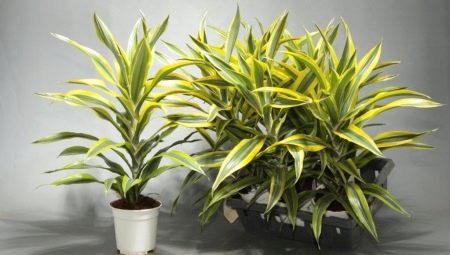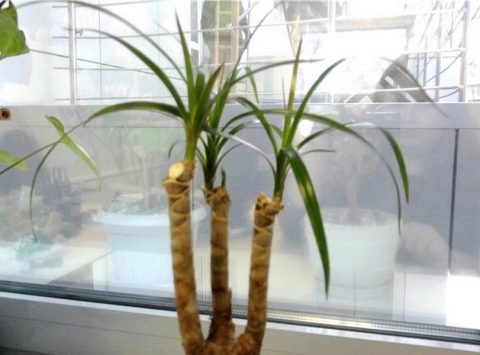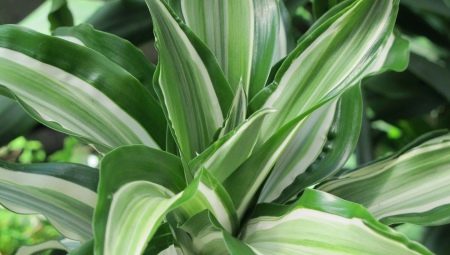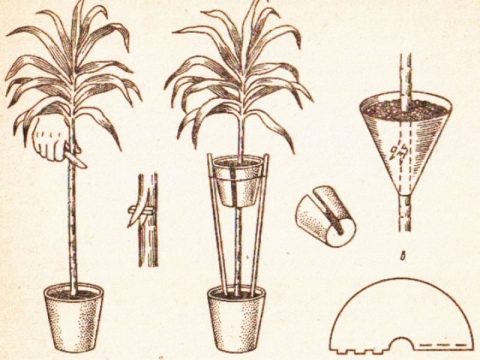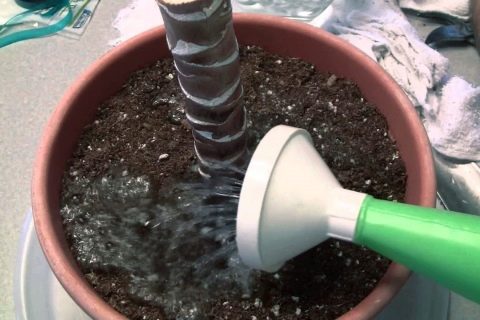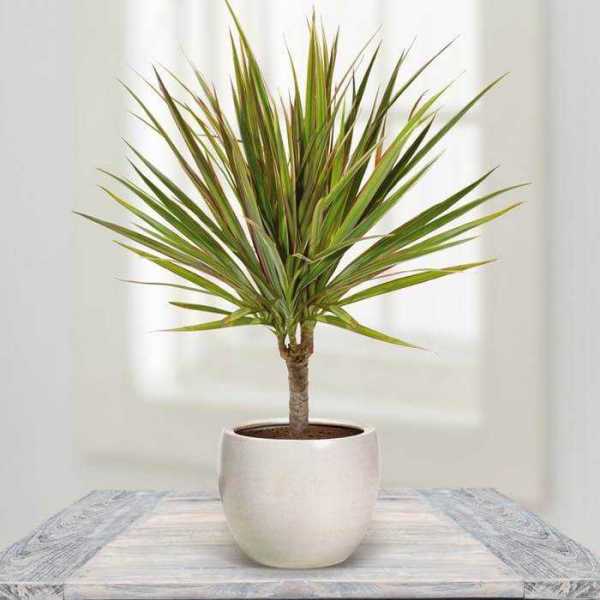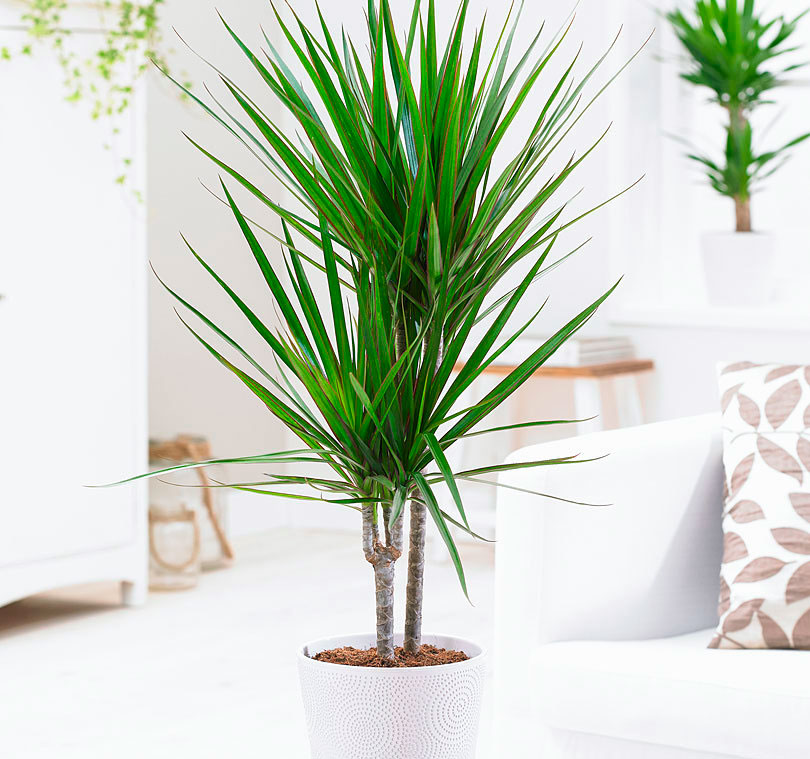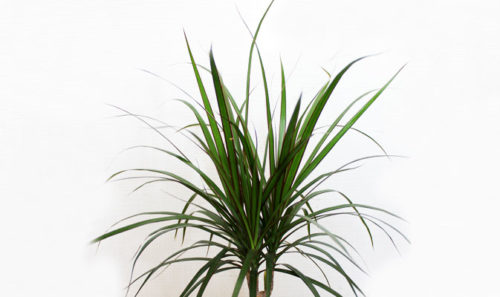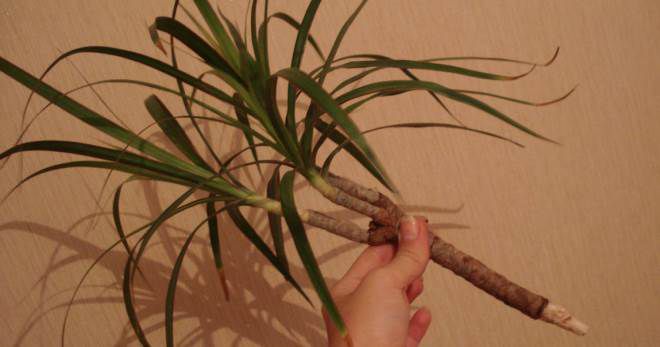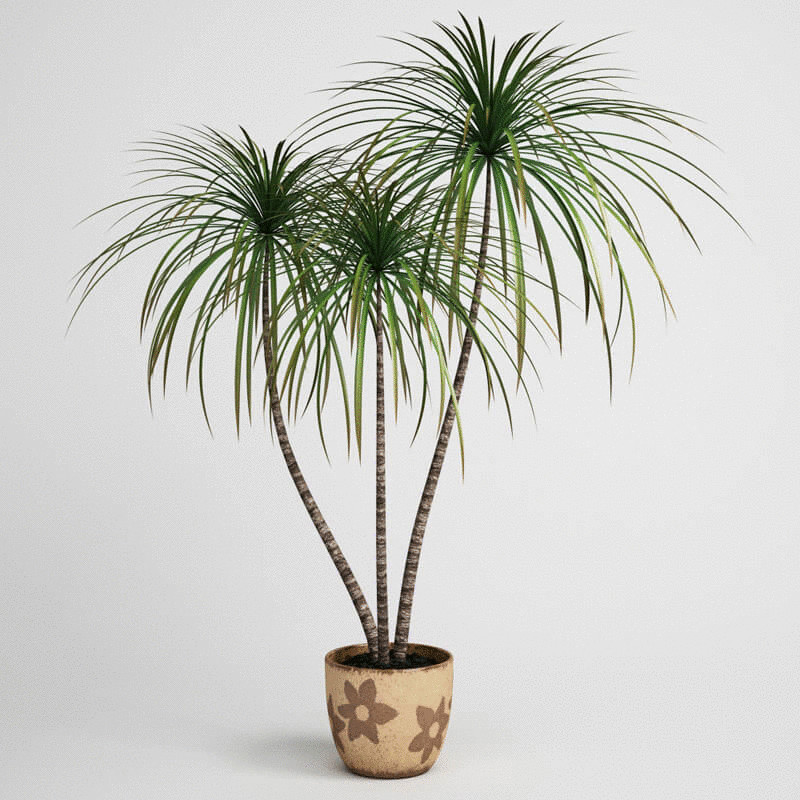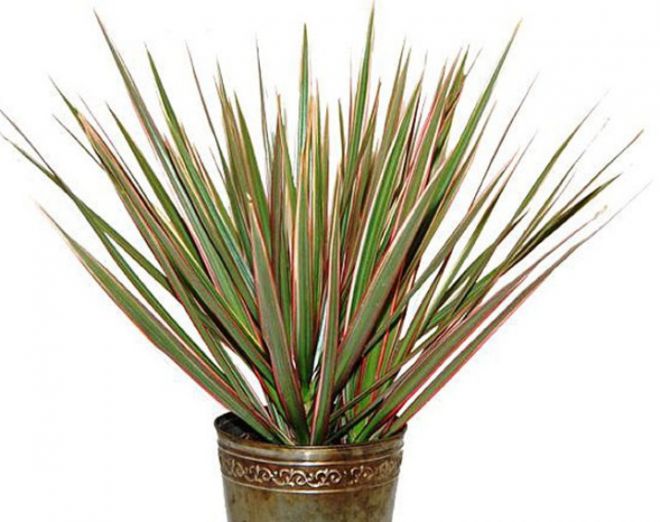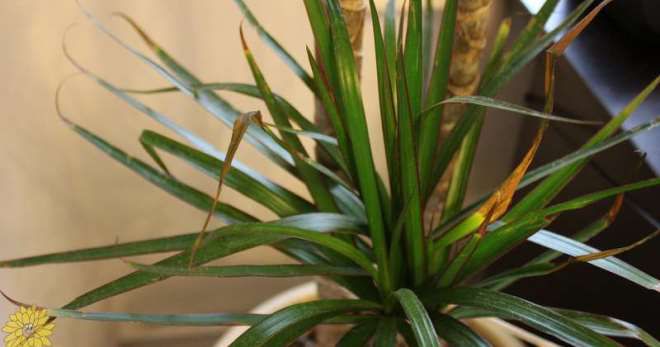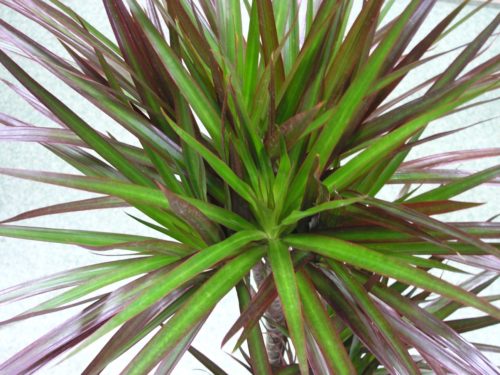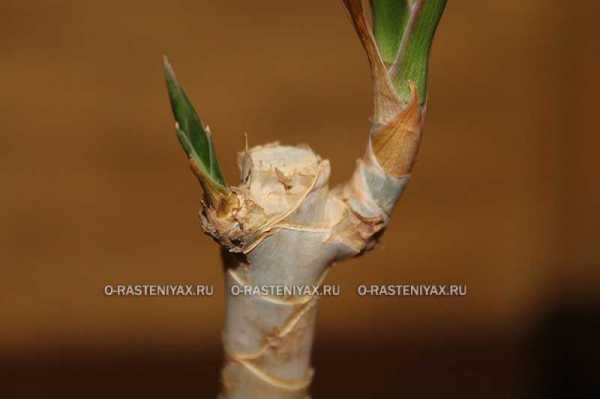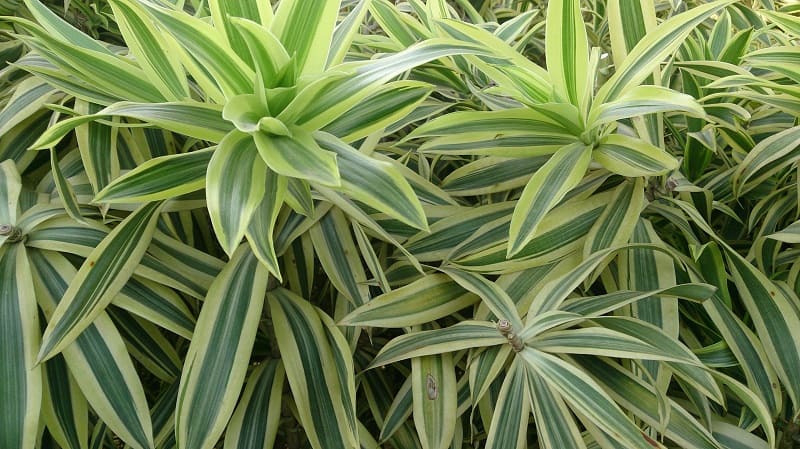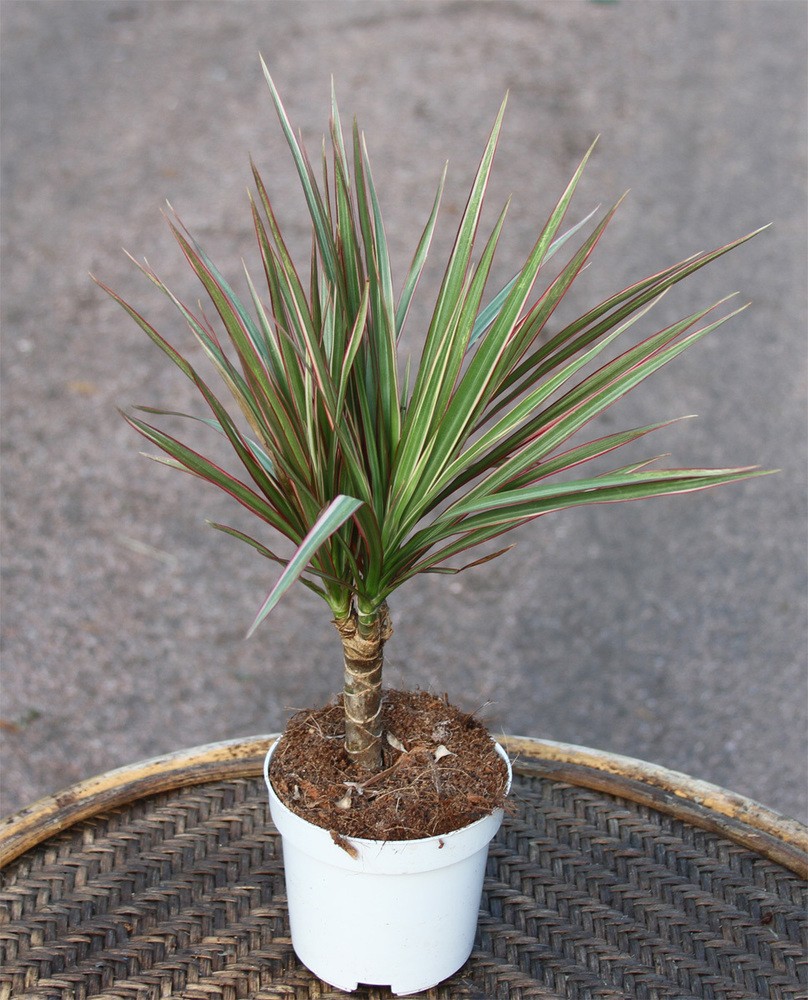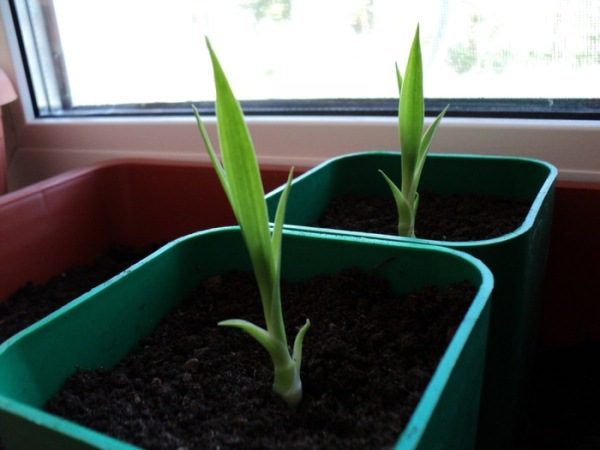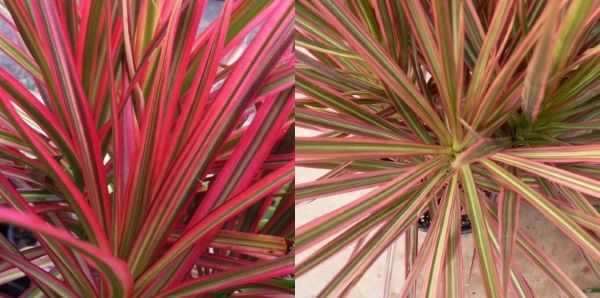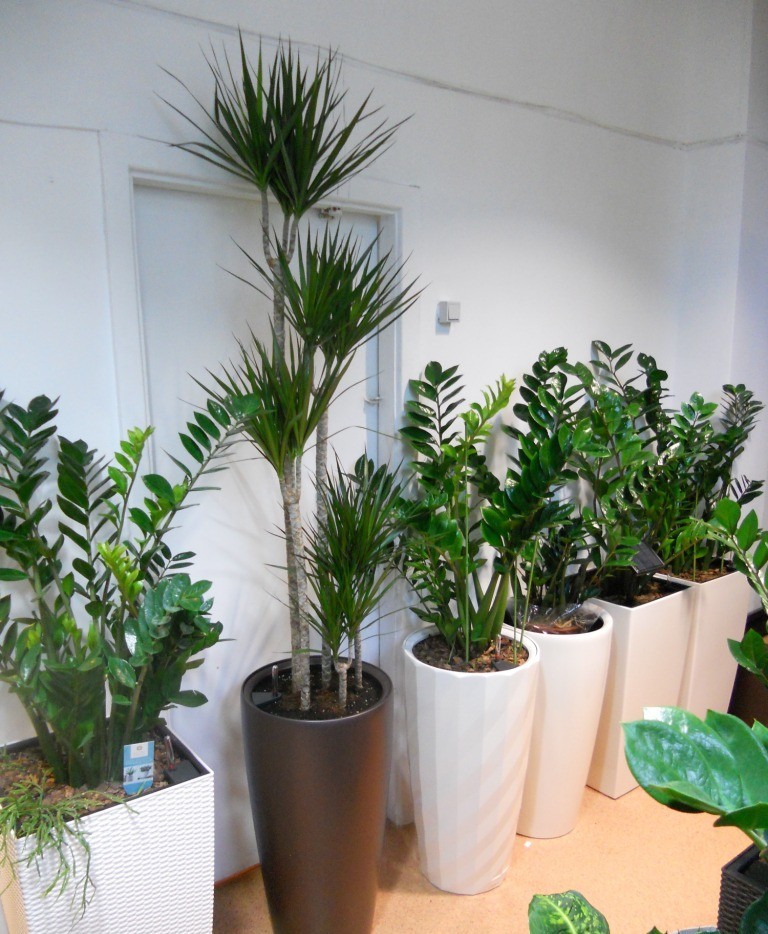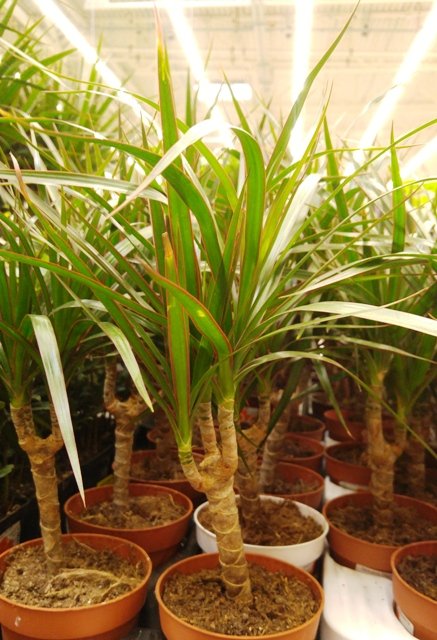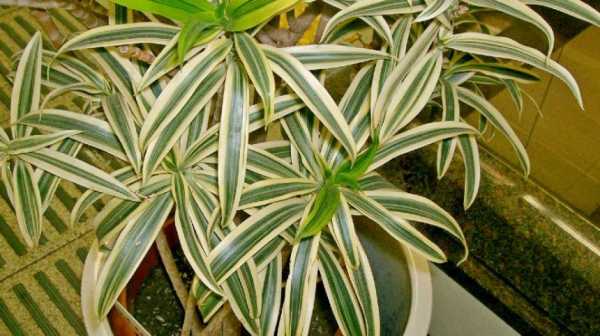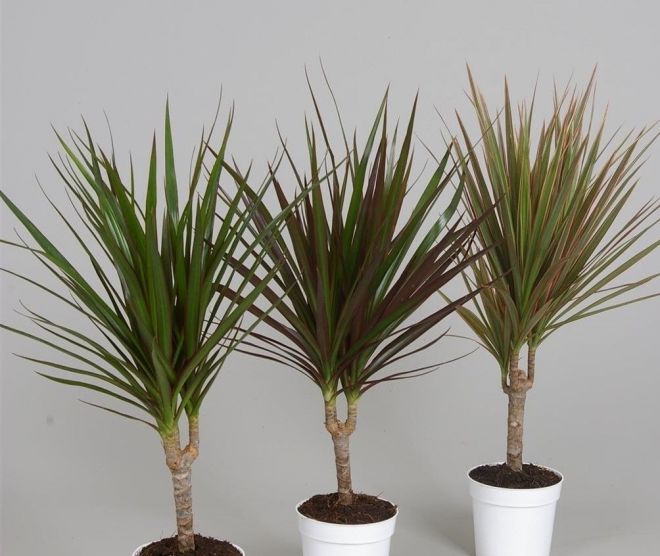Features of caring for dracaena bordered or marginate
Since it is easier to care for dracaena marginata than most other indoor crops, this species is very widely grown in different countries as a solitary plant, especially a tub plant. It requires minimal attention, develops well at room temperature both in summer and winter, it tolerates dry soil and irregular watering more easily than other flowers. The high temperature and illumination, including artificial light, inherent in office premises, corresponds to the growing conditions of this species, which explains its widespread use for decorating offices and industrial premises.
Despite the unpretentiousness of dracaena marginata, caring for it has a number of features. The plant does not tolerate any, even the most insignificant, damage to the leaf plates, which immediately affects the mode of its growth. In case of any damage or appearance of deformed leaves, it is better to remove them immediately. The place for the container with dracaena must be chosen carefully so as not to rearrange it later; for a thin unstable trunk, it is imperative to use a support.
The culture, especially its green varieties, tolerates partial shade well, but it must be remembered that spectacular variegated forms with a lack of light can become monotonous green, it is better for them to choose well-lit places protected from direct sunlight. The plant grows well near east and west facing windows.
For dracaena marginate, watering should be moderate, since its roots are very sensitive to waterlogging. In summer, the plant is watered abundantly, but only after the topsoil in the pot dries out by 2-3 cm. In winter, watering is limited, preventing the earthen coma from drying out completely. If the room temperature is high, the frequency of watering should be increased. To aerate the soil, providing air access to the roots, it is recommended to loosen the top layer of soil in the flowerpot at least once a month.
They are fed with a special fertilizer for dracaena and palms, or with complex flower fertilizer, in the summer, once every 2 weeks, in the winter, once a month, using a half dose.
The flower can grow in dry air in rooms with central heating, but to prevent the tips of the leaves from drying out, it is recommended to spray or wipe it with a damp sponge 1-2 times a day. To improve decorativeness, you can trim the dry ends of the leaves, but it is unacceptable to trim them to living tissue, this can provoke further drying out. A warm shower has a beneficial effect on the plant, cleansing the leaves from dust settling on them.
To limit growth, the top is cut off, leaving a certain number, usually 4-5, leaves on the trunk. The cut site must be treated with garden varnish or filled with paraffin. After pruning, new growth points are often formed (bundles of leaves when pruning in the leaf area, new stem growth buds when pruning in a bare section of the trunk). To stimulate this process, you can put a plastic bag over the cut site. The cut off top takes root easily, if after that it is planted in the same pot, you get an interesting composition of several tiers of the plant.
For young dracaena marginata, it is recommended to transplant every 2-3 years, trying not to damage the earthen lump. In adult specimens growing in tubs, about 5 cm of the top layer is replaced. Use ready-made soil for palm trees and dracaena, to which you can add coarse sand, pieces of charcoal or brick chips.
Plants are practically not susceptible to pests and diseases. Dracaena marginata are occasionally affected by scabies, spider mites, mealybugs. To get rid of them, spraying with insecticides is used. Of the diseases of dracaena bordered, leaf spots caused by fungi are found. Treatments are made with fungicides and copper-containing preparations.
How Dracaena Marginata reproduces
For propagation of dracaena, seeds, cuttings and the method of air layering are used.
Germinating seeds
Seed sowing is carried out from February to March.
Attention! Within 24 hours, the seeds must be soaked in the Zircon preparation, which promotes the active appearance of roots. Soaked seeds are planted at a distance of 15-20 cm in a box with fertile soil
Cover the top of the container with polyethylene to create a greenhouse. Every day, the film must be removed for 20-30 minutes in order to ventilate the ground in order to avoid the appearance of mold on it. Periodically, the seedlings need to be watered, preventing the land from drying out.
Soaked seeds are planted at a distance of 15-20 cm in a box with fertile soil. Cover the container with plastic on top to create a greenhouse. Every day, the film must be removed for 20-30 minutes in order to ventilate the ground in order to avoid the appearance of mold on it. Periodically, the seedlings need to be watered, preventing the land from drying out.
The first shoots will appear in about 30-50 days. Fertilizer is introduced once a month.
When the bores reach a height of about 5 cm, they can be replanted.

The seed method is quite laborious, and does not always give a positive result.
Rooting cuttings
To prepare the cuttings, you need to cut a healthy, sturdy branch. It needs to be cut into several pieces, each cutting should be about 5 cm long. A small incision is made on the bark on the cuttings below. The workpiece is lowered into the soil to a depth of 1-2 cm.
From above, the stalk is covered with a film or plastic jar to create a greenhouse. Keep in a warm room until roots appear. Shoots will begin to appear in about 1.5-2 months.

Cuttings are the preferred way to breed dracaena
Attention! Once a week, cuttings should be watered and sprayed with clean, filtered water at room temperature
Apical rejuvenation
From the top of the plant, you need to cut off about 15 cm of the shoot. It must be immersed in water poured into an opaque, dark container. 1 tablet of activated carbon is pre-mixed in water.
The roots will start to appear in about 3 to 3.5 months. When the root system is well developed, dracaena can be planted in nutrient soil. The planting pot is covered with foil.
This method is used quite rarely, because it takes a very long time to get results from it.
Features of caring for a flower at home
If we talk about the indoor flower dracaena Marginata, then caring for it at home is not difficult. When the right conditions are created, the plant will delight with beautiful, unusual shoots.
Temperature
Dracaena Marginata loves temperatures from +18 ° C to +25 ° C. If the room is hotter, you need to increase the frequency of watering.
Lighting
The plant loves abundant, diffused lighting. But direct sunlight should be avoided.
The best place for placement is partial shade. If the leaf plates began to fade, this indicates a lack of light. If it is impossible to provide natural light, fluorescent lamps are used.
Watering
Watering is moderate - it is impossible to pour an indoor flower at all. To understand when a plant needs water, you need to monitor the condition of the soil. It should dry 2-3 cm deep.
Spraying
Dracaena loves a shower with warm water, which helps to wash away the dust. In winter, if the room has central heating, which dries the air, you need to spray it 1-2 times a day.
Attention! For spraying, clean water at room temperature is used. Humidity
Humidity
Dracaena Marginata prefers medium to high humidity levels. Despite the fact that she may be in conditions with dry air for some time, this is best avoided. The drier the air, the faster the plant will begin to lose its decorative characteristics.
Priming
The soil must be enriched with nutrients. To grow a plant, you need to buy a special land intended for dracaena.
Top dressing
Fertilizers are applied in spring and summer for 2 weeks. Complex preparations are used. In winter, it is enough to apply fertilizer once a month.
Transfer
An adult dracaena needs to be transplanted once every 2-3 years. You can guess that she needs a new place - the previous container for the bush will become cramped, and roots will crawl out through the drainage holes at the bottom of the flowerpot.
Planting a plant in a new place is quite easy:
A new container is being prepared, which should be an order of magnitude larger than the previous pot.
A drainage layer is placed on the bottom - expanded clay or small stone; on top, fertile soil is poured from a mixture of turf and peat land.
Carefully remove the dracaena from the old flowerpot.
Using a wooden stick or a simple pencil, you need to clean the root system of the old earth.
In a new pot, the dracaena is placed in the center.
The rest of the earth is filled up, slightly compacted.
Attention! After transplants, the container with dracaena is placed in a darkened place. Do not water for 2 days
This measure will contribute to the fastest adaptation of the root system.
Dracaena marginata flower
A tropical plant from the palm family - Dracaena marginata, originally from Madagascar. Another name for the flower is Madagascar Dragon Tree. It is named so because "dracaena" is translated from ancient Greek as "female dragon". The shoots of the plant grow very quickly, in the wild they reach impressive sizes. Dracaena marginata branches weakly, and its leaves often remain only at the top.
The foliage has good decorative properties - narrow, elongated (up to 70 cm in length) bright green leaves can be decorated with red, white or pink stripes, depending on the variety. In young plants, the foliage sticks up, while in mature specimens it is horizontal or inclined towards the ground.
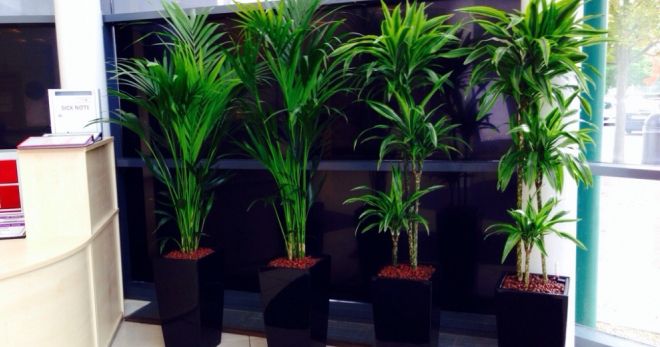
Dracaena marginata - sizes
In the wild, dracaena marginata reaches impressive sizes, the growth of the trunk occurs throughout life and reaches about 300-500 cm. There are also giant specimens up to 7-8 meters in length. Indoor varieties are more modest in size - about 50-150 cm, however, with proper care, you can grow a taller palm. A feature of this plant is that as it grows, the trunk becomes bare, and the leaves remain only at the top. To stimulate the dracaena marginata to tillering, it must be cut regularly. How to do this correctly will be discussed below.
Dracaena marginata - flowering
Many novice flower growers ask themselves: does dracaena marginata bloom? The answer to it is yes, but it is unlikely that anyone will please. The fact is that its flowers are completely unsightly - white or cream in color, and exude a very intense and unpleasant aroma. Experienced flower growers say that during the flowering period it is better to take the palm tree out of the living space. Otherwise, the pungent smell will poison the life of all household members. And it is not easy to stimulate a plant to bloom at home, therefore, this procedure is almost never resorted to.
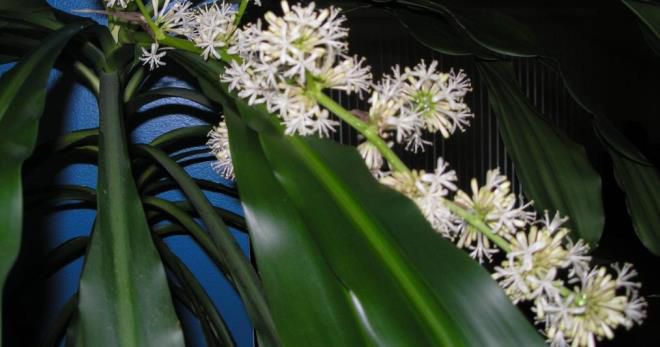
Types of dracaena marginate
Dracaena marginata palm has several artificially bred varieties that differ in stem height and leaf color. There are both monochromatic and variegated palms:
- Dracaena marginata bicolor or dracaena bordered by marginata is a palm tree with a lignified trunk and long narrow leaves of bright green color, the edges of which are decorated with a red stripe.
- Dracaena marginata magenta very similar in appearance to the previous variety. It is distinguished only by a strip of crimson color on the leaves instead of red.
- Dracaena marginata tricolor, as the name implies, has three colored stripes on the leaves - green, yellow and red.
- Dracaena marginata branched has several lignified trunks, due to this it looks more lush and is in great demand among flower growers.
- Dracaena marginata mix... The variety got its name because it was bred by crossing several palms, therefore, their appearance may differ. Leaves can be both standard narrow and wider, have one or more longitudinal stripes of different shades.
What does Dracaena Marginata look like, which family does it belong to?
Dracaena Marginata (lat.Dracaena marginata) belongs to the genus Dracaena, the Iglitsev family.
Description of appearance:
- trunk - straight, even, woody;
- the leaves are straight, narrow in shape, in appearance they are very similar to a palm tree, their arrangement is heaped, the color is light or dark shades of green, with stripes of pink, green or white;
- growth is slow, a room flower adds a maximum of 10 cm per year;
- open buds are small, creamy or white;
- aroma - fragrant, pronounced.
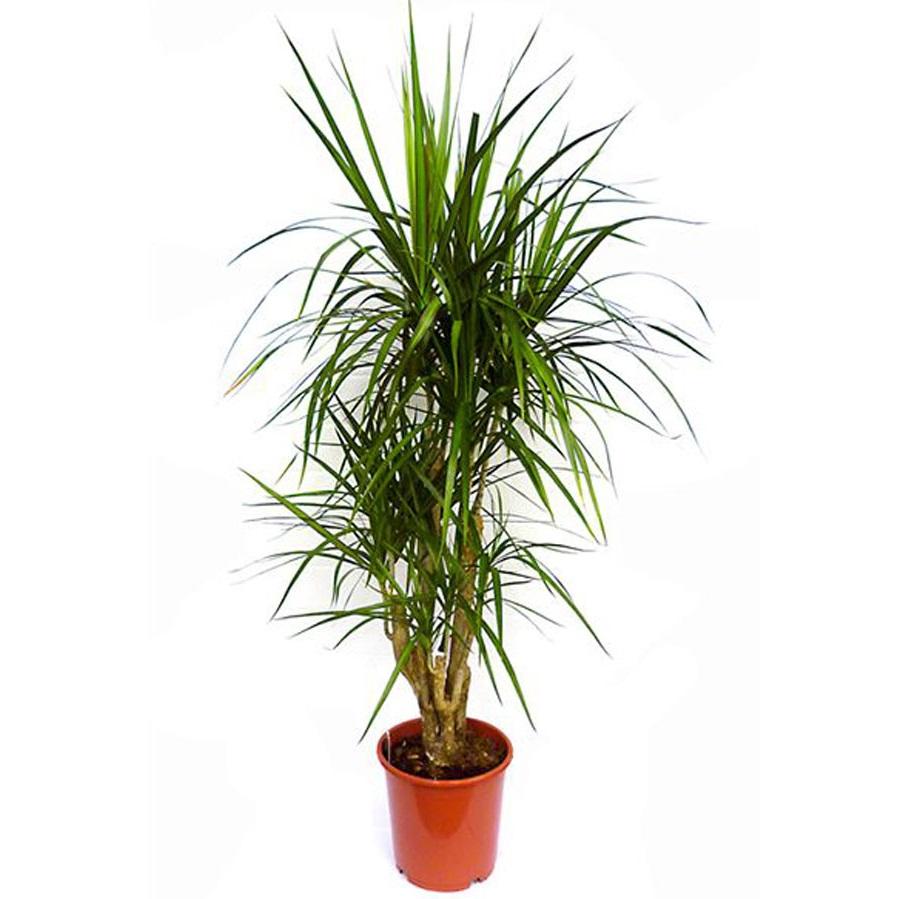
Marginata is the perfect solution to complement the office space
Dracaena's leaf plates are rather fragile; with slight mechanical stress, they can break.
Additional Information! Russian lovers of indoor plants translate Dracaena marginata in different ways - the name Dracaena Magenta is found on the Internet, the description and care of which completely coincide. Sometimes flower owners use the name Dracaena Magenta, Margarita or Marginata.
Other common varieties
Among the dracaena grown at home, there are several varieties:
- Fragrant or Fragrans is a very hardy representative of the family, the height of the plant when kept at home is up to 2 m. In the wild - up to 6 m. The buds are white, exude a strong aroma. It is recommended to use Scented Dracaena to decorate offices and winter gardens.
- Deremskaya is an evergreen plant, this is the most spectacular variety with excellent decorative characteristics. Platinum plates are painted in a deep green color, which looks beneficial in any interior.
- Bent - the leaf plates of the plant have the shape of an arc, at the base they branch. This variety rarely blooms at home. The inflorescences collected in panicles are small, painted white. Caring for the Bent Over is complex. It is grown mainly in greenhouses, where it is possible to create the necessary climatic conditions for the plant.
Dracaena Okaymlennaya, Fragrant and Deremskaya are quite easy-to-care varieties, therefore they are most often started at home and in offices.

In its natural habitat, dracaena grows tall and rampant
Medicinal properties of Marginates
In addition to its beautiful appearance, dracaena is a useful plant that has a beneficial effect on human health:
- promotes wound healing;
- used in the treatment of skin diseases of various etiologies;
- strengthens bone and dental tissue;
- has a positive effect on the central nervous system.
Additional Information! It is believed that Marginata has a strong positive energy, which she gives from herself to everyone who is in the same room with her.
Briefly about the history of appearance
There is no exact data on how the dracaena appeared. The island of Tenerife is considered her homeland. Dracaena Marginata came to Europe thanks to seafarers who were engaged in the delivery of various goods from China and India.
The name "dracaena" in translation means "female dragon".This name is associated with the legend of the origin of the plant. Dracaena appeared at the place where their blood was shed during the battle of dragons and elephants.
Additional Information! Dracaena is called dragon blood for the reason that the resin it secretes is bright scarlet, very similar to blood.
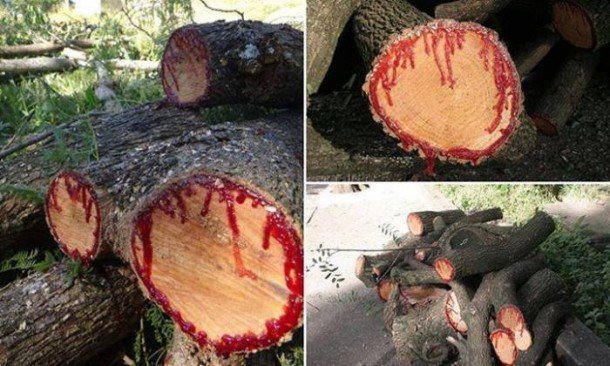
The resin of the plant looks very much like blood.
How to propagate dracaena at home
Spring is the best time to grow a new dracaena using the following breeding methods:
- seeds;
- grafting.
Seeds
Only dracaena with green leaves can be propagated by seeds, because varieties with variegated deciduous color lose their color qualities. Seeds must be planted in spring. Before planting, the seeds are placed in a stimulating solution for a day, after which they are sown in the soil. To create greenhouse conditions, the ground is watered, the pot is covered with plastic. Put it in a warm place.
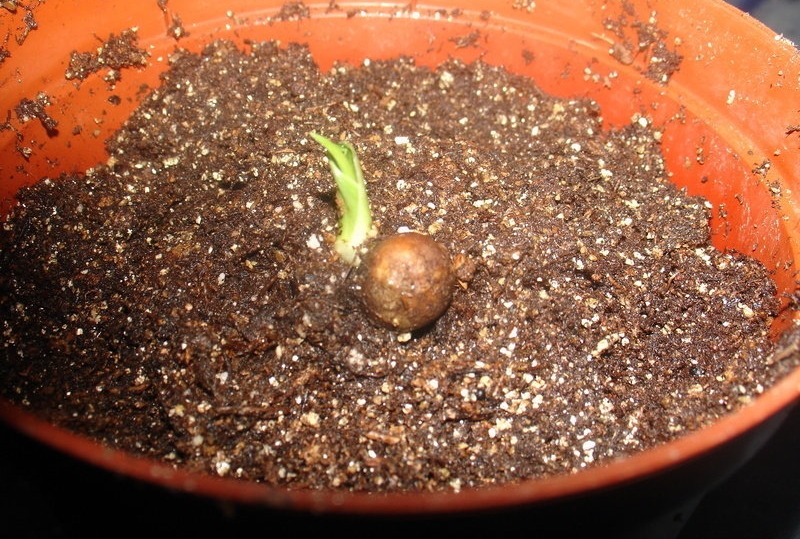
Dracaena can be obtained from seeds in spring, but shoots will appear in a couple of months.
Seedlings will appear in 1-2 months, they are regularly watered and must be fed once a month. Dracaena should be planted in pots as soon as the stems are 5-7 cm long.
Cuttings
Propagation by cuttings is the most popular and effective way to get a new plant. In order to propagate dracaena by cuttings, you need to take a young and strong plant. Progress:
- The top of the dracaena is cut by 10 cm with a sharp knife at an angle.

Propagation of dracaena by cuttings
- The resulting cuttings must be dried for 2-3 hours.
- The shoots are placed in pre-settled water at room temperature, 1 tablet of activated carbon should be put in the water so that it is clean as long as possible. The water is changed 2 times a week or as it gets dirty. You can also cut dracaena in the sand by creating a mini-greenhouse.
- Apical cuttings care:
- diffused soft light;
- air temperature not lower than + 240C;
- spraying 4 times a day.
- You can speed up root growth by adding a rooting agent to the water.
The cuttings give roots in 2-3 months, after which the young dracaena must be rooted and transplanted into a pot.
Beneficial features
In addition to the original appearance, Dracaena Okaymlennaya attracts amateur flower growers also with a number of useful properties.
Like many other dracaena, Marginata is capable of removing toxic impurities such as ammonia, benzene, formaldehyde, toluene and xylene from the air. These poisons often get into the air from cheap finishing materials. Acting as a natural air conditioner, dracaena can heal the air in any room.
In addition, this plant perfectly moisturizes the air, which is especially important during the heating season.
Due to their bactericidal properties, the plants of Dracaena Okaymelnaya, being in a living room, help prevent the occurrence of complications in diseases of the gastrointestinal tract, contribute to the early healing of wounds and the healing of skin diseases.
It is believed that they also help to strengthen the musculoskeletal system, straighten posture, and also have a positive effect on dental health.
The word "dracaena" of Greek origin means "female dragon". The origin of this name is due to the fact that when dracaena is damaged, dark red gum (thick juice) is released. The gum is used in medicine and the food industry.
The fibers of this tree in their physical properties resemble bristles or horsehair, therefore, in the homeland of plants, they are used to make brushes.
Signs and superstitions
One very interesting omen is associated with dracaena. If you plant such a plant at home, then it will certainly bring happiness and prosperity. The roots of this sign grow from an ancient Aztec legend.
Once a simple warrior fell in love with the daughter of the high priest. He will allow the guy to marry his daughter if he can get the stick to dissolve the leaves. The young man watered a stick every day, and once leaves appeared on it.It is believed that a piece of bark cut off at the full moon of this tree will bring happiness.
Dracaena Marginata is a special plant. Behind the nondescript appearance, reminiscent of a palm tree, there is a unique tree that can make the owner happy, and not only because of the legend.
vote
Article Rating
Reproduction
Since it is not so easy to get the seeds of this plant, cuttings remain the simplest and most affordable option for breeding dracaena. There are three main ways:
- trunk;
- top;
- air outlet.
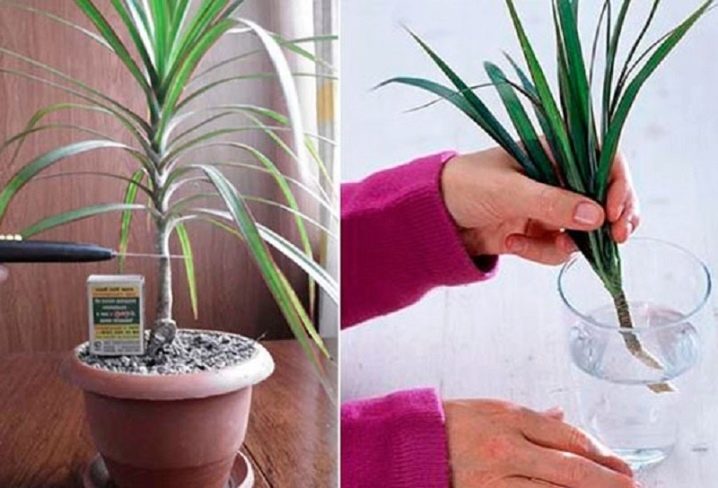
The third among them is the most difficult, as it requires attentiveness, care and time-consuming. To do this, in the place where the old leaves have fallen off, make an incision, insert a toothpick, put the moss, moisten it with water, then wrap it with polyethylene so that moisture can evaporate from above, and the plant breeder can add water from the spray bottle from above. After a few months or earlier, a separate shoot will appear, which can be transplanted into the ground, where it will feel great and grow.
Most often, the top is simply cut off, which allows not only to change the appearance of the crown on the old plant, but also to get a new, strong and beautiful tree. The planting material is placed in the lower part for several days in a solution with a growth enhancer, and then in moist soil.
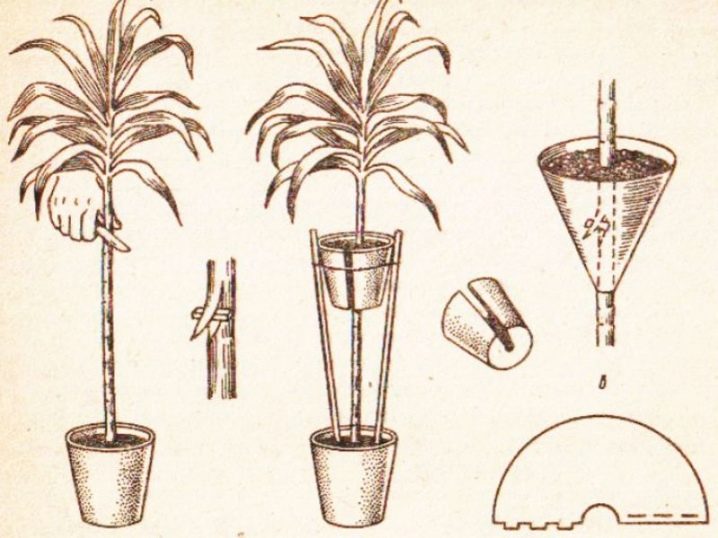
Stem propagation allows you to grow several trees at the same time. To do this, the cut trunk is first dried for several days at room temperature, then cut into pieces. Each should be stuck into the ground with the growth side up. Each piece must be at least 3 centimeters long.
If the planting material is planted in soil, it will need to be kept warm and moist, and when they try to root in water, the liquid is changed every day and made sure that it is not cold. After the required number of roots has appeared, the plant is planted in potting compost.
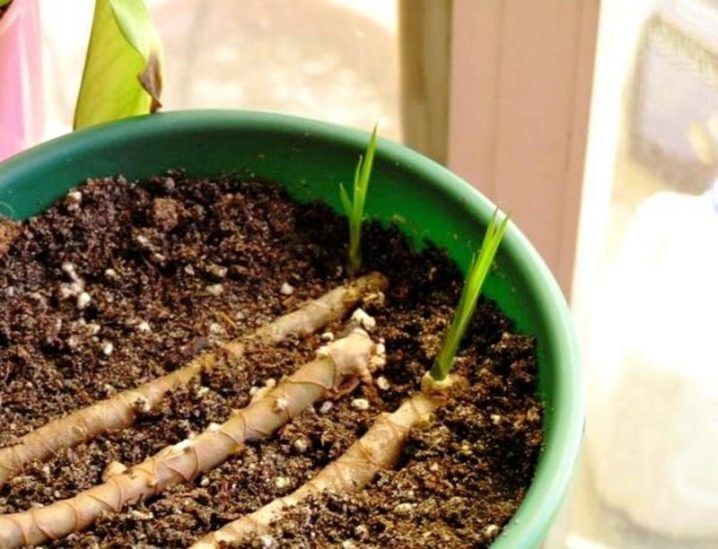
Home care
How to care for a plant at home? Dracaena Marginata is very unpretentious, this, first of all, explains its incredible popularity in indoor breeding.
Features of care after purchase
After purchasing dracaena, the main rule must be observed - as soon as possible, transplant it, at least within a month.
How to transplant dracaena Marginata?
Transfer
In addition to the first transplant immediately after purchase, Marginat needs to be transplanted every 2-3 years into a larger pot.
When transplanting, you need to be extremely careful to avoid damage to the roots.
It is preferable to choose a special soil intended for dracaena or palm trees. It is advisable to loosen the soil in the pot from time to time, this contributes to better plant growth.
Lighting
Dracaena Bordered does not require a large amount of sunlight, diffused light is enough for it. Therefore, it is perfect for landscaping areas where little natural light penetrates, for example, for offices.
But it is undesirable to place the plant in a dark place either. With a strong lack of light, its appearance suffers: the leaves become lighter, and the appearing shoots are pulled towards the light source. To avoid curving the silhouette of the tree, it is necessary to regularly turn the pot at a small angle.
The best place for Marginata is on the opposite side of the window. The main thing, in order to avoid burning the leaves, do not put it in direct sunlight.
This rule does not apply only to the bicolor variety, whose plants like morning and evening direct sunlight.
Temperature
Dracaena Okaymelnaya perfectly suits the temperature range of 18-22 ⁰С in winter and 25-28 С in summer. If possible, it is better to move the flower to the balcony during the heat.
At the same time, it is important to exclude the occurrence of drafts, which this plant is very afraid of.This fact must be taken into account during winter ventilation - if the dracaena is standing near the window, it is better to temporarily cover it
Dislikes wood and sudden temperature changes
This fact must be taken into account during winter ventilation - if the dracaena is standing near the window, it is better to temporarily cover it. Dislikes wood and sudden temperature changes.
During the heating season, it is not recommended to place the dragon tree near the radiator and other heating devices, because it feels very bad in dry air.
Air humidity
The homeland of Dracaena Marginata is tropical islands with high humidity, so it is necessary to provide her with a similar microclimate when grown at home. Air humidity should preferably be maintained at a level of at least 60%, for this you need to regularly spray the leaves with water. But the plant will also not like too high humidity (more than 80%), especially in winter.
It is undesirable to allow dust accumulation on the leaves.
Dust can be removed by wiping or rinsing in the shower. To avoid erosion of the soil during the operation, the pot can be wrapped in plastic.
For spraying, wiping and rinsing the plant, you need to use water at room temperature.
Watering
In the hot season, the plant must be watered abundantly, 2 - 3 times a week, and in the most intense heat - spray the leaves with water at room temperature. If the tips of the leaves begin to dry and break, most likely the flower does not have enough moisture. But if the leaves turn yellow, then, most likely, watering is excessive.
It is especially important not to overdo it with watering dracaena in winter. It is enough to water the plant once a week if the soil does not have time to dry out.
Fertilizers (top dressing)
The soil for growing Marginata must be nutritious and moisture-consuming. You can buy the substrate at the store or prepare it yourself. A mixture of leaf, turf and peat is best.
As for fertilizers, Marginata does not have any particular preference for feeding. The main requirement for fertilizer: high content of nitrogen, potassium and phosphorus. During active growth (from spring to autumn), fertilizing should be added to the water for irrigation 1-2 times a week, and during the rest period (in winter) - once every 1-2 weeks.
Bloom
Dracaena Bordered at home blooms extremely rarely, usually when uncomfortable conditions are endured. Its flowers are small, inconspicuous, white or green, with a specific heavy odor. Therefore, if you are lucky enough to see your dracaena blooming, it is better to take it out of the room for a while.
To increase the chance of forming an ovary from a flower, artificial pollination is carried out with a brush with soft bristles. In case of successful ovary formation and seed ripening, the seeds can be used for reproduction.
The magical properties of a flower
Bordered dracaena is especially popular in China. Residents of the Celestial Empire consider this exotic tree to be ideal gifts for loved ones and even call it "the bamboo of happiness." In their opinion, happiness will come to the house where Dracaena Marginata grows.
And the magical properties of the flower are truly remarkable, they are manifested in the following:
- attraction of positive energy;
- strengthening of friendships and love relationships;
- purification of the energy of thoughts, words and feelings;
- improving health;
- help in wound healing;
- treatment of various skin diseases;
- positive effect on the musculoskeletal system;
- significant extension of life;
- improving the financial situation.
Feng Shui advises placing the "bamboo of happiness" on the floor near the front door.
The number of plant shoots in the composition is also important, since:
- three - attract happiness;
- five - provide financial stability;
- seven - promote health;
- twenty-one - bring success to any undertaking.
Of particular note is the composition called "Tower of Love", which is created from twenty twisted stems of dracaena Marginata.

